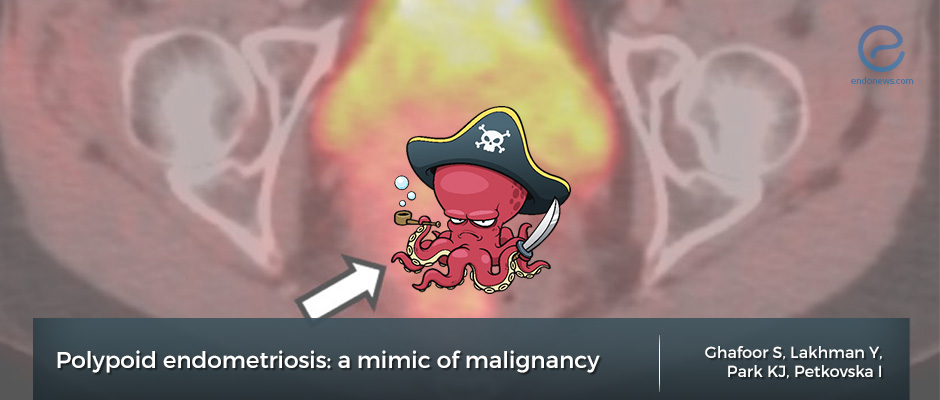Not a malignancy, it is "polypoid endometriosis"
Aug 25, 2019
Polypoid endometriosis is a rare mass-like variant of endometriosis.
Key Points
Highlights:
- Polypoid endometriosis is commonly seen in peri- to postmenopausal women and is generally associated with exposure to Tamoxifen or hormone replacement therapy.
- The ovaries, uterine serosa, vagina and, large bowel are the most common locations affected by polypoid endometriosis.
Importance:
- Radiologists and clinicians should be aware of polypoid endometriosis since it mimics malignancy preoperatively, especially on imaging.
What's done here:
- Polypoid endometriosis is discussed over a case of a 60-year-old asymptomatic postmenopausal woman with an incidental pelvic mass mimicking a pelvic malignancy on ultrasound.
Lay Summary
Ghafoor S. et al., from Memorial Sloan Kettering Cancer Center, NY, USA, has recently reported a case of a 60-year-old postmenopausal woman with an incidental pelvic mass mimicking a pelvic malignancy on ultrasound. Their paper has been published in the journal Abdominal Radiology.
The patient had a history of a remote supracervical hysterectomy for symptomatic leiomyomata and resection of benign breast cysts. She had no remarkable medical history. Of note, she had been on continuous hormonal replacement therapy for the past 10 years. The mass was localized in the cul-de-sac touching the cervix anteriorly and the rectum posteriorly. The patient did not have any symptoms, ascites, peritoneal implants or lymphadenopathy. On MRI, the mass had high-signal intensity on T2-weighted images, a peripheral low T2 signal intensity rim, lack of diffusion restriction and mild enhancement following intravenous contrast administration. Imaging findings on FDG-PET/CT were non-specific.
Firstly, malignancy arising from the cervical remnant, endometriosis-associated malignancy or rectal tumor was considered as a diagnosis. The mass was biopsied transvaginally and the histopathologic diagnosis of the specimen was consistent with polypoid endometriosis.
Although classic endometriosis and polypoid endometriosis often co-exist in the same patient, this patient did not have classic endometriosis.
Three months after cessation of hormone replacement therapy, the mass decreased in size on follow-up MRI.
According to the limited literature, the patients with polypoid endometriosis were found to be older compared with patients with classic endometriosis which usually presents before menopause. Similar to classic endometriosis, the polypoid variant was related to estrogenic stimulation, e.g., hormone replacement therapy or Tamoxifen use. The ovaries, uterine serosa, vagina and, large bowel were the most common locations affected by polypoid endometriosis.
To sum up, polypoid endometriosis is a rare mass-like variant of endometriosis which radiologists should be familiar with. Since it mimics malignancy, polypoid endometriosis poses a diagnostic challenge both clinically and radiologically. Knowledge of important clinical and imaging features including older age (peri- or postmenopausal age group), association with hormonal treatment, MR signal characteristics mirroring endometrium, T2 hypointense peripheral rim and high signal on DWI/ADC may aid in narrowing the differential possibilities.
Research Source: https://www.ncbi.nlm.nih.gov/pubmed/?term=31372776
polypoid endometriosis magnetic resonance imaging MRI endometriosis-associated malignancy

